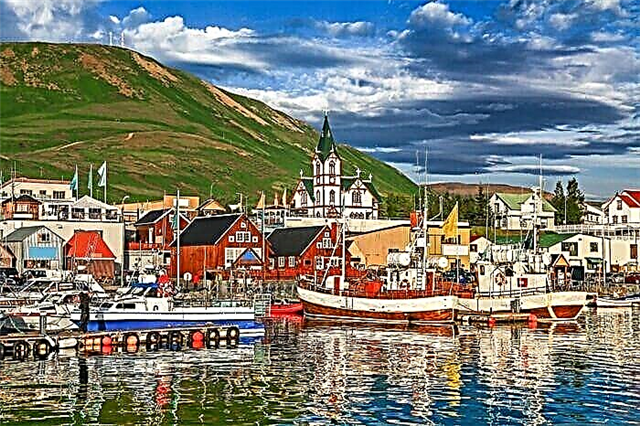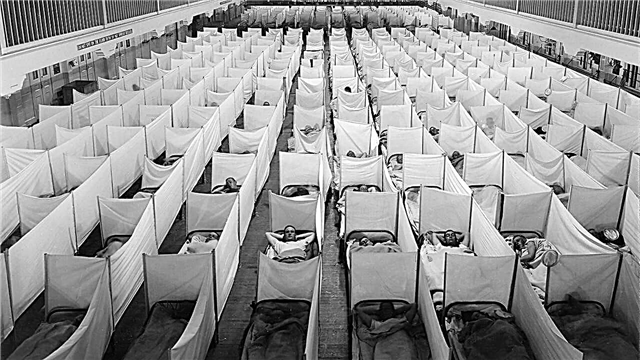Each year, the US Peace Fund ranks world states according to their level of economic and political stability. And the lower the indicators, the more stable the country is considered. Once the rating was called rather rigidly - “Index of failed states”, however, under pressure from the public, the name had to be changed to a rating of “incapacity”.
The criteria used to evaluate a country include:
- the level of authority of the elites and their control over power structures,
- the ability of the state to deal with crime,
- level of social inequality,
- demographic situation,
- the ratio of immigrants / emigrants, social protection, the presence / absence of pressure from neighboring countries and much more.
| A place | Country | Score |
|---|---|---|
| 1 | Finland | 16,9 |
| 2 | Norway | 18,0 |
| 3 | Switzerland | 18,7 |
| 4 | Denmark | 19,5 |
| 5 | Australia | 19,7 |
| 6 | Iceland | 19,8 |
| 7 | Canada | 20,0 |
| 8 | New Zealand | 20,1 |
| 9 | Sweden | 20,3 |
| 10 | Luxembourg | 20,4 |
| 11 | Ireland | 20,6 |
| 12 | Germany | 24,7 |
| 13 | Netherlands | 24,8 |
| 14 | Austria | 25,0 |
| 15 | Portugal | 25,3 |
| 16 | Slovenia | 28,0 |
| 17 | Singapore | 28,1 |
| 18 | Belgium | 28,6 |
| 19 | France | 32,0 |
| 20 | South Korea | 33,7 |
| 21 | Uruguay | 34,0 |
| 22 | Japan | 34,3 |
| 23 | Malta | 34,5 |
| 24 | United Kingdom | 36,7 |
| 25 | Czech Republic | 37,6 |
| 26 | United States | 38,0 |
| 27 | Lithuania | 38,1 |
| 28 | Mauritius | 38,9 |
| 29 | Chile | 38,9 |
| 30 | United Arab Emirates | 40,1 |
| 31 | The Slovak Republic | 40,5 |
| 32 | Spain | 40,7 |
| 33 | Estonia | 40,8 |
| 34 | Costa Rica | 42,0 |
| 35 | Poland | 42,8 |
| 36 | Italy | 43,8 |
| 37 | Latvia | 43,9 |
| 38 | Qatar | 45,4 |
| 39 | Argentina | 46,0 |
| 40 | Panama | 47,0 |
| 41 | Croatia | 47,5 |
| 42 | Romania | 47,8 |
| 43 | Barbados | 48,0 |
| 44 | Bahamas | 48,8 |
| 45 | Hungary | 49,6 |
| 46 | Oman | 50,0 |
| 47 | Bulgaria | 50,6 |
| 48 | Trinidad and Tobago | 53,0 |
| 49 | Kuwait | 53,2 |
| 50 | Greece | 53,9 |
| 51 | Mongolia | 54,1 |
| 52 | Antigua and Barbuda | 54,4 |
| 53 | Seychelles | 55,2 |
| 54 | Montenegro | 55,3 |
| 55 | Brunei Darussalam | 57,5 |
| 56 | Grenada | 57,6 |
| 57 | Cyprus | 57,8 |
| 58 | Albania | 58,9 |
| 59 | Botswana | 59,5 |
| 60 | Malaysia | 60,5 |
| 61 | Cuba | 60,8 |
| 62 | Jamaica | 61,2 |
| 63 | Kazakhstan | 61,6 |
| 64 | Suriname | 61,9 |
| 65 | Belize | 62,5 |
| 66 | Bahrain | 63,8 |
| 67 | Samoa | 64,2 |
| 68 | Macedonia | 64,6 |
| 69 | Ghana | 65,9 |
| 70 | Vietnam | 66,1 |
| 71 | Dominican Republic | 66,2 |
| 72 | Namibia | 66,4 |
| 73 | Cape Verde | 66,6 |
| 74 | Armenia | 66,7 |
| 75 | Paraguay | 67,0 |
| 76 | Moldova | 67,1 |
| 77 | Serbia | 68,0 |
| 78 | Peru | 68,2 |
| 79 | Guyana | 68,2 |
| 80 | Belarus | 68,2 |
| 81 | Mexico | 69,7 |
| 82 | Maldives | 69,8 |
| 83 | El Salvador | 69,8 |
| 84 | Tunisia | 70,1 |
| 85 | Saudi Arabia | 70,4 |
| 86 | Indonesia | 70,4 |
| 87 | Gabon | 70,5 |
| 88 | Ukraine | 71,0 |
| 89 | South Africa | 71,1 |
| 90 | Sao Tome and Principe | 71,1 |
| 91 | China | 71,1 |
| 92 | Ecuador | 71,2 |
| 93 | Bosnia and Herzegovina | 71,3 |
| 94 | Turkmenistan | 71,4 |
| 95 | Fiji | 71,7 |
| 96 | Brazil | 71,8 |
| 97 | Georgia | 72,0 |
| 98 | Butane | 72,0 |
| 99 | Bolivia | 72,9 |
| 100 | Morocco | 73,0 |
| 101 | Micronesia | 73,0 |
| 102 | Thailand | 73,1 |
| 103 | Azerbaijan | 73,2 |
| 104 | Benin | 73,6 |
| 105 | India | 74,4 |
| 106 | Russia | 74,7 |
| 107 | Algeria | 75,4 |
| 108 | Uzbekistan | 75,7 |
| 109 | Colombia | 75,7 |
| 110 | Jordan | 75,9 |
| 111 | Republic of Kyrgyzstan | 76,2 |
| 112 | Israel and the West Bank | 76,5 |
| 113 | Senegal | 77,2 |
| 114 | Tajikistan | 77,7 |
| 115 | Honduras | 77,8 |
| 116 | Nicaragua | 78,1 |
| 117 | Laos | 78,7 |
| 118 | Lesotho | 79,7 |
| 119 | Tanzania | 80,1 |
| 120 | Turkey | 80,3 |
| 121 | Madagascar | 80,9 |
| 122 | Guatemala | 81,4 |
| 123 | Comoros | 81,7 |
| 124 | Solomon islands | 81,9 |
| 125 | Cambodia | 82,5 |
| 126 | Equatorial Guinea | 82,6 |
| 127 | Iran | 83,0 |
| 128 | Philippines | 83,1 |
| 129 | Papua New Guinea | 83,1 |
| 130 | Malawi | 83,3 |
| 131 | Gambia | 83,9 |
| 132 | Burkina Faso | 83,9 |
| 133 | Sri Lanka | 84,0 |
| 134 | Nepal | 84,7 |
| 135 | Lebanon | 85,0 |
| 136 | Djibouti | 85,1 |
| 137 | Eswatini | 85,3 |
| 138 | East Timor | 85,5 |
| 139 | Zambia | 85,7 |
| 140 | Sierra leone | 86,8 |
| 141 | Go | 87,4 |
| 142 | Rwanda | 87,5 |
| 143 | Bangladesh | 87,7 |
| 144 | Angola | 87,8 |
| 145 | Egypt | 88,4 |
| 146 | Mozambique | 88,7 |
| 147 | Venezuela | 89,3 |
| 148 | Mauritania | 90,1 |
| 149 | Liberia | 90,2 |
| 150 | Ivory Coast | 92,1 |
| 151 | Libya | 92,2 |
| 152 | Republic of the Congo | 92,5 |
| 153 | North Korea | 92,7 |
| 154 | Kenya | 93,5 |
| 155 | Pakistan | 94,2 |
| 156 | Ethiopia | 94,2 |
| 157 | Myanmar | 94,3 |
| 158 | Mali | 94,5 |
| 159 | Uganda | 95,3 |
| 160 | Guinea bissau | 95,5 |
| 161 | Niger | 96,2 |
| 162 | Eritrea | 96,4 |
| 163 | Cameroon | 97,0 |
| 164 | Burundi | 98,2 |
| 165 | Nigeria | 98,5 |
| 166 | Iraq | 99,1 |
| 167 | Haiti | 99,3 |
| 168 | Guinea | 99,4 |
| 169 | Zimbabwe | 99,5 |
| 170 | Afghanistan | 105,0 |
| 171 | Sudan | 108,0 |
| 172 | Chad | 108,5 |
| 173 | Central African Republic | 108,9 |
| 174 | Congo, D.R. | 110,2 |
| 175 | Syria | 111,5 |
| 176 | south sudan | 112,2 |
| 177 | Somalia | 112,3 |
| 178 | Yemen | 113,5 |
Here's what the top 10 most stable countries in the world in 2019 look like.
10. Luxembourg
 Instability: 20.4 (less is better)
Instability: 20.4 (less is better)
This is a tiny European state, the population of which does not reach 600 thousand people. However, despite its size, Luxembourg is second in the world in terms of wealth, second only to the richest Arab country - Qatar. The per capita GDP here is simply stunning - more than 105 thousand dollars!
The country owes its wealth to a large number of private banks. Luxembourg is a real tax haven for large corporations, many of which local financiers are helping to reduce tax payments through individual ultra-low rates.
9. Sweden
 Instability: 20.3
Instability: 20.3
One of the most prosperous countries in the world for many years in principle respects neutrality. This position in the international arena, coupled with a commitment to human rights and economic sustainability, increase Sweden's credibility in international affairs.
Like other Scandinavian countries, Sweden is a capitalist country. However, the share that the Swedish state allocates to social services is much higher than the global average. Add to this a progressive tax rate, well-developed infrastructure and transport network, as well as free health care and specialized secondary education, and you will understand why the life expectancy of Swedes is one of the highest in the world (82.2 years).
8. New Zealand
 Instability: 20.1
Instability: 20.1
Most of the 4.7 million people in New Zealand live on the northern island. Low population density and the absence of large predators allow New Zealanders and tourists to freely travel around the archipelago. And the places there are beautiful. You probably know that it was in New Zealand that the famous trilogy of Peter Jackson, The Lord of the Rings, was filmed.
One of the most stable countries in 2019 lives mainly on the export of agricultural products, meat, poultry and wine. Per capita income is quite high ($ 39,000), and education spending as a percentage of GDP is one of the highest in the world.
7. Canada
 Instability: 20
Instability: 20
The country of beavers and lakes occupies almost two fifths of the North American continent, and in size is second only to Russia. With such a huge area, it is sparsely populated, and most of the residents are concentrated near the border with the United States, since the climate there is a little better.
An important part of Canadians' national identity is multiculturalism; the Canadian government is extremely positive about immigrants and strongly invites them to itself.
Both the economy and the political system of Canada have remained unchanged for many years. For example, this country still nominally remains a constitutional monarchy ruled by the British queen. In practice, this translates into the fact that the Canadian Prime Minister appoints a “decorative” governor-general who participates in various beautiful ceremonies. Canada also has traditionally strong cultural and economic ties with the United States.
6. Iceland
 Instability: 19.8
Instability: 19.8
For many years now, Iceland has been in the top ten of various ratings, ranging from the health of the nation to the safest country in the world. It is amazing how this tiny island nation with a population of just 340 thousand people managed to achieve such prosperity.
There is almost no crime in the country, Iceland has no army, but there is free education and a high level of gender equality. And finally, there are no mosquitoes in Iceland at all, they just don’t survive there! Sounds like heaven on Earth, right?
5. Australia
 Instability: 19.7
Instability: 19.7
Although the Australians finally broke all ties with the mother country in the 80s of the last century, the British Queen is still the nominal head of Australia. But the country does not live only in the past. Its economy stands on two pillars - a developed services sector and active export of goods.
The demographic policy of the Australian authorities consists in attracting highly qualified specialists from around the world to the country. Therefore, Australia is one of the most accessible countries for migration in the world.
And living in this country is so good that the life expectancy of both women and men is one of the highest in the world.
4. Denmark
 Instability: 19.5
Instability: 19.5
In fourth place in the ranking of the most stable states in the world is Denmark, which serves as a gateway between the Scandinavian peninsula and the rest of Europe. In its capital, Copenhagen, is the largest airport in Scandinavia, as well as the famous bridge that connects the city with Sweden.
One of the indicators of state stability is the invariability of its political system, and Denmark is very indicative in this regard. For a century it has been ruled by kings and queens (though since the middle of the 19th century it has been purely nominal).
Thanks to a progressive taxation scale, healthcare services in the country are almost free. Like higher education. Another advantage of the country is the excellent work of social elevators. That is, any person can become literally anyone - from an official or the head of a large corporation to a scientist or a senior military officer.
3. Switzerland
 Instability: 18.7
Instability: 18.7
For centuries, Switzerland has been neutral in all the shocks of Europe. The last conflict that the country remembers occurred in the middle of the 19th century, when the confederation of cantons turned into a federal republic. Since then, Switzerland has enjoyed peace and prosperity.
Now the country has a very low unemployment rate, a strong economy, the lion's share of which is occupied by a well-developed services sector, including financial.
Interesting fact: despite its small size, Switzerland gave the world more Nobel Prize winners than all other states of the world.
2. Norway
 Instability: 18
Instability: 18
Once upon a time, the Vikings drove the inhabitants of Europe into fear. But these times have passed and now Norway is very respectable and stable.
GDP per capita is 72 thousand dollars, private initiative is booming, and the population has a good airbag from the state in the form of social benefits. All these benefits are provided by “black gold”: the oil found in the 60s of the last century spurred the Norwegian economy well.
Norwegians are very fond of reading, and the country is among the leaders in the number of books published per capita.
1. Finland
 Instability: 16.9
Instability: 16.9
Finland is considered the most stable state by the Peace Fund. She is the happiest country in 2019, according to the World Happiness Report.
Finns strictly respect human rights, and once this country was one of the first to give women the opportunity to vote. The Finnish economy is capitalistic, but a significant part of the budget is spent on social protection and public services. For example, education among Finns is considered one of the most affordable in the world. However, the country is not confined to its small, cozy little world, and at least a third of its GDP falls on international trade.
Like all developed countries, the problem of aging populations is acute in Finland. Due to the drop in the birth rate, it can be difficult to maintain the level of well-being that the Finns have already got used to.
Russia takes 106th place in the list of the most stable countries in the world with a sufficiently high "total score" of instability - 74.7. For comparison: the most unstable country in the world (Yemen), this figure is 113.5 out of 120 possible. And the nearest neighbors of Russia - Ukraine and Belarus - 71 and 68.2, respectively.












